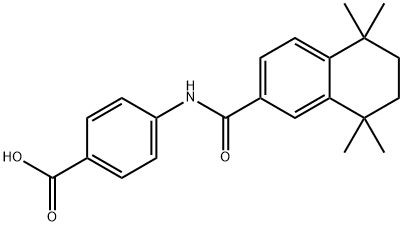102121-60-8
 102121-60-8 结构式
102121-60-8 结构式
基本信息
RARΑ激动剂(AM580)
4-(5,5,8,8-四甲基-5,6,7,8-四氢化萘-2-甲酰氨基)苯甲酸
4-[(5,6,7,8-四氢-5,5,8,8-四甲基-2-萘基)甲酰氨基]苯甲酸
AM 580
CS-1051
l)amino-
ro40-6055
NSC 608001
AM580 (CD336)
AM-580
AM 580
CD336
NSC608001
RO 40-6055
4-(1,1,4,4-Tetramethyltetralin-6-ylcarbonylamino)benzoic acid
4-[(5,6,7,8-TETRAHYDRO-5,5,8,8-TETRAMETHYL-2-NAPHTHALENYL)CA...
物理化学性质
| 报价日期 | 产品编号 | 产品名称 | CAS号 | 包装 | 价格 |
| 2024/08/19 | HY-10475 | 4-[(5,6,7,8-四氢-5,5,8,8-四甲基-2-萘基)甲酰氨基]苯甲酸 AM580 | 102121-60-8 | 5mg | 600元 |
| 2024/08/19 | HY-10475 | 4-[(5,6,7,8-四氢-5,5,8,8-四甲基-2-萘基)甲酰氨基]苯甲酸 AM580 | 102121-60-8 | 10mM * 1mLin DMSO | 660元 |
| 2024/08/19 | HY-10475 | 4-[(5,6,7,8-四氢-5,5,8,8-四甲基-2-萘基)甲酰氨基]苯甲酸 AM580 | 102121-60-8 | 10mg | 900元 |
常见问题列表
In the presence of G-CSF, AM580 (at 10 -8 M) produces a remarkable induction in LAP mRNA of NB4 cells. At a concentration of 10 -5 M, AM580 and ATRA, in combination with G-CSF, induce almost the same level of LAP transcript. AM580 (at 10 -8 M) leads to an approximately sixfold increase in the steady-state levels of the transcript coding for the G-CSF receptor in NB4 cells. AM580 (50 nM) increases caspase-3 expression in all of the colonies, and in 30% of the colonies induce acinar-like cavitation. Knockdown of RARγ1 in primary Myc cells using shRARγ1 followed by Am580 treatment results in an even higher level of CRBP1 expression, showing that in these cells RARγ has a repressive effect on the RARα target gene CRBP1 . Am580 (200 nM) enhances the anti-proliferative effect exhibited by RARγ knockdown in the MCF-10A and MCF-7 cell lines but not in the MDA-MB-231 cells.
Am580 (0.3 mg/kg/day) treatment has a more profound effect on tumor-free survival of MMTV-wnt1 mice, the effect being noticeable even in early appearing tumors, and no overt toxicity is found in liver, lungs, kidney, and spleen. Am580 treatment reduces substantially and equally the level of hyperplasia in both transgenic glands. Treatment of MMTV-Myc mice with the RARα-selective agonist Am580 leads to significant inhibition of mammary tumor growth, lung metastasis and extends tumor latency in 63% of mice.